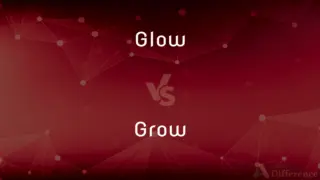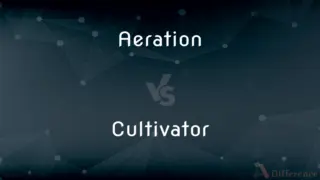Transparent vs. Clear — What's the Difference?
By Tayyaba Rehman & Fiza Rafique — Updated on March 1, 2024
Transparent materials allow light to pass through with minimal distortion, enabling clear visibility of objects behind them. Clear materials are transparent but specifically imply an absence of color, ensuring undistorted and sharp visibility.

Difference Between Transparent and Clear
Table of Contents
ADVERTISEMENT
Key Differences
Transparent materials, by definition, allow light to pass through them, enabling the observation of objects on the other side. This characteristic is essential in various applications, from glass windows to plastic wraps, where visibility through the material is required. The key aspect of transparency is the ability to see through the material, regardless of its color or tint.
Clear, on the other hand, is a subset of transparent materials that not only allow light to pass through but do so without imparting any coloration to the light. Clear materials are often sought after for applications requiring an unaltered view of the other side, like eyeglasses or camera lenses, where any color distortion could affect the clarity of vision or the accuracy of the captured images.
All clear materials are transparent, but not all transparent materials are clear. For example, a colored glass bottle may be transparent, as you can see light through it, but it is not clear because the glass’s color alters the light’s appearance. This distinction is crucial in fields requiring precise optical properties, such as optics and photonics.
The degree of transparency can vary among materials, with some allowing light to pass through almost perfectly, while others may scatter light, causing objects behind them to appear blurred. This scattering effect, however, does not affect whether a material is considered transparent but rather how effectively it maintains clarity.
Clearness is often associated with purity or quality, especially in materials used for optical purposes. A higher degree of clearness implies fewer impurities or structural flaws, leading to better transmission of light and sharper visibility of objects seen through the material.
ADVERTISEMENT
Comparison Chart
Definition
Allows light to pass through, enabling visibility of objects behind.
A type of transparency without color distortion.
Color Distortion
May or may not alter the color of transmitted light.
Does not alter the color of transmitted light.
Clarity
Objects behind can be seen, clarity varies.
Ensures sharp and undistorted visibility of objects behind.
Examples
Colored glass, tinted windows.
Clear glass, purified water.
Application
Broad, where visibility through the material is required.
Where precise optical properties are needed without altering the light.
Compare with Definitions
Transparent
Allowing light to pass through so that objects behind can be distinctly seen.
The transparent curtains let sunlight into the room.
Clear
Completely transparent, allowing light to pass without any obstruction or color distortion.
The clear glass vase held a bouquet of roses.
Transparent
Material that permits the passage of light without significant scattering.
The transparent acrylic sheet served as a protective barrier.
Clear
Free from any haze, cloudiness, or impurities.
After filtration, the water was perfectly clear.
Transparent
Capable of being seen through with clarity, though color may be present.
The artist used transparent layers of paint to create depth.
Clear
Material or substance that offers unimpeded visibility.
The clear plastic wrap preserved the food's freshness without hiding it.
Transparent
Property of a substance that enables clear perception of depth or layers.
Transparent ice on the lake revealed fish swimming below.
Clear
Describes a quality of being easily seen or understood.
His explanation was clear, leaving no room for confusion.
Transparent
Materials that allow visibility, emphasizing depth and detail.
Her transparent approach to storytelling captivated the audience.
Clear
Used to describe conditions or substances where maximum transparency is achieved.
The sky was clear, enabling a perfect view of the stars.
Transparent
So fine in texture that it can be seen through; sheer.
Clear
(of a substance) transparent; unclouded
The clear glass of the French windows
A stream of clear water
Transparent
Capable of transmitting light so that objects or images can be seen as if there were no intervening material.
Clear
Easy to perceive, understand, or interpret
Am I making myself clear?
Her handwriting was clear
Clear and precise directions
Transparent
Permeable to electromagnetic radiation of specified frequencies, as to visible light or radio waves.
Clear
Bright; luminous; not dark or obscured.
The windshield was clear and clean.
Congress passed the President’s Clear Skies legislation.
Transparent
Easily seen through or detected; obvious
Transparent lies.
Clear
Unmixed; entirely pure.
Clear sand
Transparent
Obvious; readily apparent; easy to see or understand.
His reasons for the decision were transparent.
I love playing poker with Steve, because he's so transparent.
Clear
In a clear manner; plainly.
Transparent
Of an image or animated gif, having parts that do not overwrite the color of the background the image is placed over.
Clear
To render bright, transparent, or undimmed; to free from clouds.
He sweeps the skies and clears the cloudy north.
Transparent
Having the property of transmitting rays of light, so that bodies can be distinctly seen through; pervious to light; diaphanous; pellucid; as, transparent glass; a transparent diamond; - opposed to opaque.
Clear
The state of being free of suspicion;
Investigation showed that he was in the clear
Transparent
Easily understood or seen through (because of a lack of subtlety);
A transparent explanation
A transparent lie
Clear
Clear from impurities, blemishes, pollution, etc.;
Clear the water before it can be drunk
Clear
Make clear, bright, light, or translucent;
The water had to be cleared through filtering
Common Curiosities
Why is clarity important in materials?
Clarity is crucial for applications requiring precise visibility and optical accuracy, such as in lenses, windows, and scientific equipment.
How does a material's transparency affect its usage?
The degree of transparency determines its suitability for various applications, with clear materials preferred for optical clarity and colored transparent materials used for aesthetics or filtering light.
Can a colored material be transparent?
Yes, a colored material can be transparent if it allows light to pass through, but it would not be considered clear due to the coloration.
What does it mean for a material to be clear?
A clear material allows light to pass through without any color distortion, ensuring that objects behind are seen accurately.
Can transparency be measured?
Yes, transparency can be measured in terms of light transmission percentage, with higher values indicating greater transparency.
What makes a material transparent?
A material is transparent if it allows light to pass through it, enabling objects behind it to be seen.
Is transparency the same as translucency?
No, transparency allows clear visibility of objects behind, while translucency lets light pass through but scatters it, preventing clear visibility.
Are all transparent materials equally clear?
No, the clarity of transparent materials varies based on their ability to transmit light without distortion or scattering.
What role does material purity play in clarity?
Material purity is crucial for clarity, as impurities can cause scattering or absorption of light, reducing transparency.
Can the clarity of a transparent material be improved?
Yes, through processes like polishing, coating, or refining, the clarity of transparent materials can be enhanced.
Why might someone choose a transparent material over a clear one?
Someone might choose a transparent material for aesthetic reasons or to achieve specific light-filtering effects, where coloration is desired.
What advancements have been made in transparent and clear materials?
Advancements include the development of ultra-clear glass and plastics, anti-reflective coatings, and materials with improved durability and light transmission properties.
How do environmental factors affect transparency and clarity?
Environmental factors like dust, moisture, and wear can reduce both transparency and clarity by introducing surface imperfections and scattering light.
What is the significance of clear materials in optics?
In optics, clear materials are essential for lenses and other components that require precise light transmission for accurate imaging.
How do manufacturers ensure material clarity?
Manufacturers employ purification and quality control processes to minimize impurities and structural flaws that could impair clarity.
Share Your Discovery

Previous Comparison
Glow vs. Grow
Next Comparison
Aeration vs. CultivatorAuthor Spotlight
Written by
Tayyaba RehmanTayyaba Rehman is a distinguished writer, currently serving as a primary contributor to askdifference.com. As a researcher in semantics and etymology, Tayyaba's passion for the complexity of languages and their distinctions has found a perfect home on the platform. Tayyaba delves into the intricacies of language, distinguishing between commonly confused words and phrases, thereby providing clarity for readers worldwide.
Co-written by
Fiza RafiqueFiza Rafique is a skilled content writer at AskDifference.com, where she meticulously refines and enhances written pieces. Drawing from her vast editorial expertise, Fiza ensures clarity, accuracy, and precision in every article. Passionate about language, she continually seeks to elevate the quality of content for readers worldwide.















































